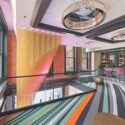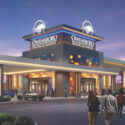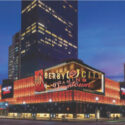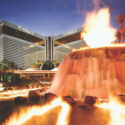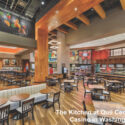The stage is set. Hosts stand at attention to greet patrons coming from the bustling casino floor. Inside, couples relax in overstuffed chairs in quaint alcoves framed by fireplaces and trickling fountains. Candlelight and soft music set the mood; heavy menus adorned with gold braid foreshadow the price point.
An attentive wait staff caters to their every need. It is a quality experience from the moment they arrive until the time they leave.
Welcome to today’s signature casino restaurant. It’s a far cry from the $7.77 Gambler’s Special, a steak dinner once offered 24 hours a day in casino coffee shops. These days, the casino customer is more sophisticated, educated by the Food Network, with an increasing awareness of fine dining and the snob appeal of celebrity chefs.
“Things have really changed in the gaming circles,” says Corey Nyman, director of operations for Nyman Group restaurant consultants. “People are willing to pay for fine dining; it doesn’t always have to be ‘comped.’ So casinos have to decide whether their restaurants are going to be amenities to the high rollers or a money-making venture.”
“The high-end casino restaurant used to be a loss leader,” adds Richard Dobransky, vice president of food and beverage for Delaware North, a 95-year old company that has worked with restaurants in a variety of settings, from casinos to stadiums. “Since they catered to high rollers, they would just give the meal away. But that’s not the case anymore.”
More and more, casinos are opting for the moneymakers, putting in a signature restaurant, or two or three. But what really goes into such a venture, and how do you ensure its success? Below, industry experts sound off about the challenges and rewards of creating today’s signature casino restaurant.
Pre-Concept
Before you make a single decision, much less bring in a brand name chef, do your homework.
“We come in and do qualitative research,” says Michael Soll, executive vice president of the Innovation Group. “We do focus groups with current and future customers, we do telephone and Internet surveys. We find out what people want and how excited they are about it. Then we can make recommendations and extrapolate the kind of revenue that could be generated.”
“We do a lot of analysis,” says Nyman. “We look at the property’s strengths, weakness, demographics, food and labor costs and restaurant competition in the area. We meet with key people at the property, from management down to the casino host and the people responsible for player development.
“We want to understand who their customer is so we can make recommendations for the type of restaurant. If management wants a Mexican cantina but the market is demanding a steakhouse, they need to know that.”
The Nyman Group did all the restaurants at Trump Taj Mahal in Atlantic City. Not only did they analyze the opportunities on property, they also assessed the draw to the local market by non-gamers.
“To some extent, locals are going to drive your business,” says Nyman. “You have to look at the barriers to entry. How difficult is it for them to get to the restaurant? How far is parking? Is there a valet? Do they have to walk through a smoke-filled casino in order to get there? We take all of these issues into account.”
Ultimately, the consensus is that casinos must be sure that a signature restaurant appeals to players and locals alike. But that’s not all. It has to be different from any other restaurant at the property, and ideally at competing properties too.
One way to create that exclusivity is to bring in a celebrity chef or other innovative concept.
Star Chef or In-house Talent?
Bobby Flay Steak, Wolfgang Puck American Grille and Emeril’s New Orleans are all examples of successful celebrity restaurant concepts. The match between celebrity chefs and casinos, however, is relatively new.
“We were the first celebrity chef in a casino,” says Tom Kaplan, senior managing partner of the Wolfgang Puck Fine Dining Group. “When we were approached about opening in Vegas, they said it would ruin our reputation. But it’s done just the opposite.”
“For us, the decision to open a Wolfgang Puck restaurant really starts with who the partner is,” Kaplan says. “We look for the right partner, then the right location. It’s not just about putting our name on the door. We’re not interested in just collecting a management fee. We are present.”
Puck himself makes personal appearances nightly in Los Angeles, where he lives, and visits his other locations faithfully.
“Usually at the beginning, you have to decide whether your property needs a celebrity chef for exposure,” says Paul Heretakis of Westar Architects, a firm that has worked with celebrities like Paula Deen and Mario Batali. “Remember that the celebrity chef will drive both the décor and the food.”
They also take some of the profits, according to industry experts. Michael Soll of the Innovation Group says a casino in-house restaurant offers more control, but there are benefits to bringing in a name as well.
“Do you want to create something in-house and forge a signature profile or do something out of house?” he asks. “Then you have to decide if you’re going to lease the space or work with a management group or the restaurateur. It sometimes depends on who’s putting up the capital. Celebrity chefs are supplying less and less capital, but they’re getting the kind of media attention that sometimes in-house restaurants do not.”
One reason to bring in a celebrity is to reach the client you don’t have, says Heretakis. “When we opened Mia at Caesars in Atlantic City, it was a great marriage for the property and for Chris Scarduzio and Georges Perrier. Their core customers in Philly already knew the brand, and it’s close enough that they’d drive an hour to a new destination to try that new restaurant.”
“Everybody seems to want a celebrity chef,” says Corey Nyman. “Personally, we’re indifferent. Is the celebrity chef going to make the most money? Or do we want to save that money, which could be 15 percent to 30 percent? You might get the initial flash with the press, but is it going to be sustained?”
Heretakis adds, “Of course, if you don’t have a star to bring in customers, you need to come up with a great concept.”
Designing the Space
Once the concept is created, the next step is design.
“Sometimes the property has it nailed down, and sometimes it changes,” says Bryan Hamlin, vice president of design for the WorthGroup. “There’s a lot of fluidity. Our job is to realize the vision of the restaurant.”
And just as patrons’ expectations of fine dining have risen, so has the pressure to create a signature design.
“Design is so mainstream these days,” Hamlin says. “Because of the media, design concepts have become much more accessible to the public. So the level of design has been elevated to a much higher standard.”
To some extent, space dictates design as well.
“If the location is on the water, near the casino floor, in a larger or smaller space, all of those elements affect the design,” says Floss Barber of Floss Barber, Inc. “With most upscale restaurants, however, there are design elements that are constant. For example, we ‘announce’ that it’s upscale with an entrance that feels exclusive. Even the entry itself is an experience.”
“You don’t want it to be crowded in this type of restaurant,” says Barber. “The choice of materials will be more refined. The lighting might be concealed or if not, we might use signature lighting pieces.”
Designers “choreograph” the path that patrons will take.
“There is a sequence of arrival,” says Hamlin. “This gives us an opportunity for installation of artwork, views to the outside. There’s a movement to introduce natural lighting in perimeter places, moveable partitions, outside dining where possible to open up the space.
“You want to build the level of ambiance, sophistication and privacy, so the acoustics are very important. You want to be able to have a conversation.”
Designers may also get involved in more than the physical space. They often make recommendations on server’s uniforms, menus, and even nametags.
“Black and white is a classic look for a server,” says Nyman. “But if you have an upscale steakhouse with a bold theme, you can go for open collars and a more vibrant feel. Functionality is key. They have to be able to move and work in their uniforms.”
Nyman doesn’t believe in nametags. “Most guests don’t take the time to look at them,” he says. “I’d rather that they introduce themselves as part of their script.”
Of course, design is another area where a celebrity chef often gets involved.
“In the case of Mario Batali, the design of the room was secondary to the simplicity of the food,” says Heretakis. “In other restaurants, you’ll see that the rooms are as much of a ‘star’ as the chef is.'”
The Menu
The menu is a natural result of the concept, whether it’s signature in-house or celebrity chef.
The important point to remember is that the menu caters to the customer. That’s why Bobby Flay’s Mesa Grill at Caesars Palace offers a Caesar salad and strip steak.
“Yes, it’s a Southwestern concept,” says Nyman, “but it’s still approachable. So we include menu items that we know will sell.”
Wolfgang Puck has created five distinctly different brands with different menus to address a range of customers, from the upscale Spago to the more playful American Grille. In all, Puck has 14 restaurants, each with an executive chef who’s worked with Wolfgang for many years.
“Our menus may vary in each location, as our décor does,” says Kaplan. “Our chefs are very talented in their own right and Wolfgang encourages creativity and exploration, within the concept of course. We also work with the local growers and producers in the region. We might do certain dishes in Maui with a focus on fish, while in Beaver Creek we’d focus on game. Then of course, if someone wants a dish cooked specially, we’ll accommodate them.”
The Next Big Thing
“Everyone’s looking for the next big trend,” says Soll. “Who’s the next big chef? What’s the next great concept?”
“I’d say the classic steakhouse has about five years left,” says Dobransky of Delaware North. “It has been the hottest thing in recent years, but now we’re also seeing a trend toward more specialty restaurants, like Asian fusion.”
“It’s important to stay ahead of the trends,” Nyman agrees. “You can’t come in the middle. You have to watch what’s going locally, statewide, nationally and even worldwide. It’s not enough to stay inside the bubble of the restaurant community.”
One thing is certain. With the increased emphasis on fine dining, and increasing discernment among casino patrons, it will just keep getting better and better. Bon appetit.




